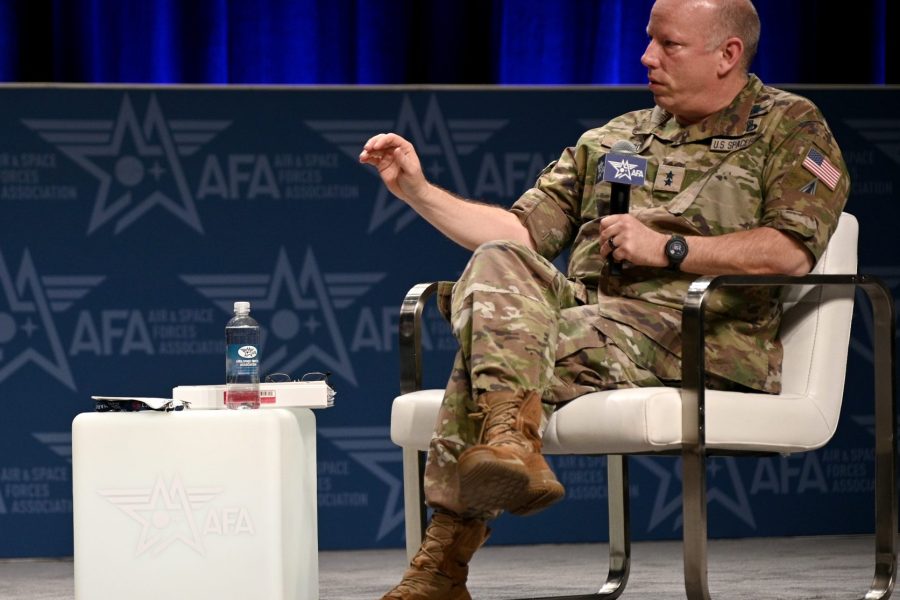Space Force leaders say that while they’re eager to implement the Pentagon’s newly announced acquisition transformation strategy, civilian personnel cuts and a prolonged government shutdown have depleted the acquisition and contracting workforce, adding to pressures on the cadre that could make it difficult to hit the ground running on reform.
“We’re in a really interesting time, and a troubling time,” the Space Force’s acting acquisition executive Maj. Gen. Stephen Purdy said Nov. 20 at a Center for Strategic and International Studies event. “We have a strong, motivated force, but there have been an incredible amount of pressures on them in this past year. … We are in a situation where we barely have enouch acquirers to do all the work that we have now.”
The Space Force has seen an outsized impact from the Trump administration’s push to reduce the size of the federal workforce through mandatory civilian reductions and deferred resignation and retirement programs that incentivized early separation. Chief of Space Operations Gen. B. Chance Saltzman told lawmakers in May that the service has taken a 14 percent cut to its civilian workforce this year, nearly double the reduction some other federal agencies have seen. Many of those came from Space Systems Command, the USSF’s acquisition hub at Los Angeles Space Force Base, Calif.
At the same time, the service has been working over the last year to streamline its buying practices and is bracing for an influx of new acquisitions. Those initiatives align closely with—and in many cases have foreshadowed, Purdy said—a slate of acquisition reforms Defense Secretary Pete Hegseth unveiled earlier this month that aim to diversify the defense industrial base, promote commercial buying practices, increase competition, and incentivize government acquirers and defense firms to deliver systems faster and in greater numbers.
The Space Force is excited and motivated to implement Hegseth’s reform agenda, Purdy said, but he’s also concerned the service’s acquisition team isn’t sized for success or trained to quickly pivot to a new way of doing business.
“You need a large number of people just to even track that activity,” he said. “You need to be able to understand what’s going on, understand the incentive structure.”
That’s especially true in contracting, where the shift to more competition and innovatitve contract structures means that program teams that used to manage one or two contracts per system are now juggling 15 or 20. The service has taken this approach in pockets within SSC and the Space Development Agency, and Hegseth’s strategy calls for expanding it.
“This is literally what acquisition reform is telling us to do, to bring multiple bidders all the way through the proceess into the end game, into production. Fantastic approach,” Purdy said. “But that increases the workload on program teams. That increases the workload on your contracting teams. So it’s something we’ve really got to get after.”
While defense firms have started to see improvements in the Space Force’s acquisition processes, they’ve also taken notice of the strain the Space Force’s acquisition workforce is under, according to Kay Sears, vice president and general manager of space, intelligence, and weapon systems at Boeing.
“The openness to understanding what drives cost and schedule, where the trades might be, the willingness to talk up front and really understand those things—it has never been better,” said Sears, who spoke on the panel with Purdy. “But you can tell they’re stressed. You can tell they’re overworked.”
The Space Force has made some progress addressing the immediate impact of workforce cuts. The service has sought and obtained waivers from Hegseth’s office to hire replacements and, in some cases, rehire individuals. Lt. Gen. Philip Garrant, SSC’s commander, told reporters in September that he is working to rebuild USSF’s acquisition workforce so that, even if it’s leaner than it once was, it’s better positioned to implement new reforms.
On the training side, the service has announced a first-of-its-kind initial qualification course for acquisition officers. The 10-week course is a deep dive into program management, testing, and contracting, and provides mentorship opportunities with industry experts and Space Force leaders. Its Office Training Course, which is for all of the service’s officers, also includes time spent learning the acquisitions process.
Purdy also has some “aspirational” plans to further revamp the service’s acquisition training programs to make sure it has the right expertise in the right disciplines. He said the USSF is considering establishing an acquisition center of excellence modeled on a similar organization in the National Reconnaissance Office.
“That’s an element that we are looking to try to build in the Space Force,” he said. “It’s still on the aspirational list.”


